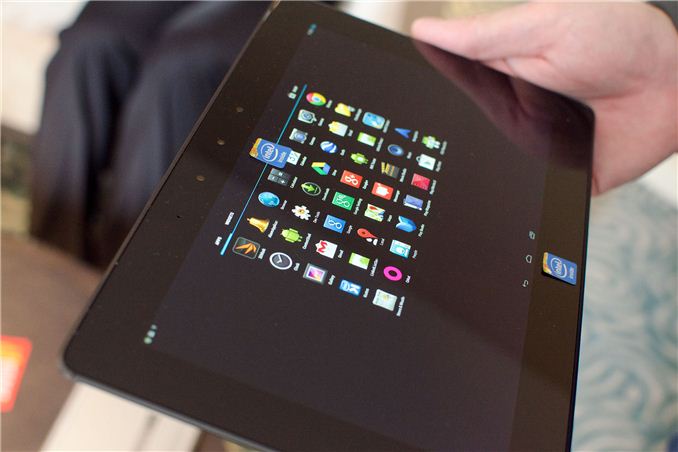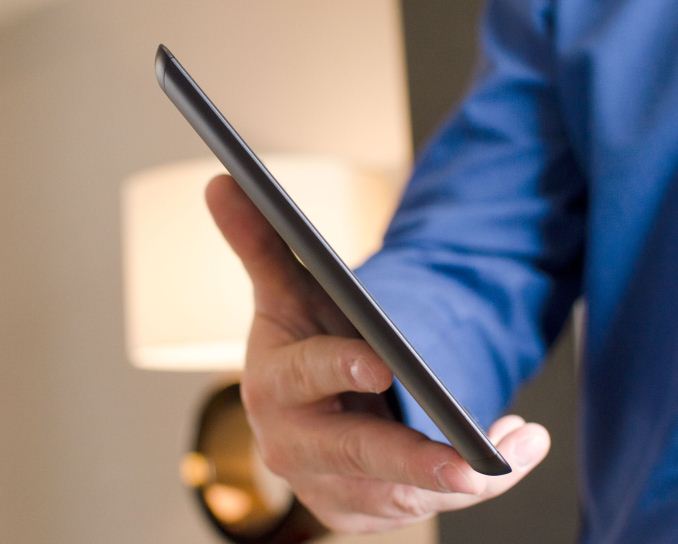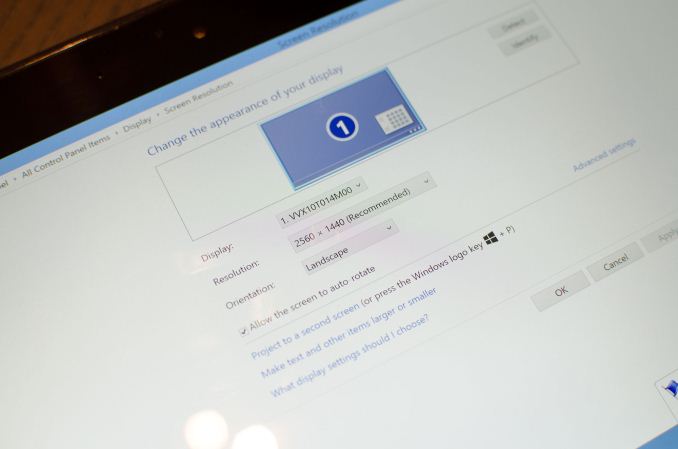Intel Demonstrates Bay Trail-T Running Windows 8 and Android 4.2.2
by Anand Lal Shimpi on June 6, 2013 8:19 PM EST- Posted in
- Tablets
- Intel
- Atom
- Mobile
- Silvermont
- Trade Shows
- SoCs
- Computex 2013

Last month Intel took the covers off its next-generation Atom microarchitecture, codename Silvermont. The first consumer implementation of Silvermont will be Bay Trail, a quad-core SoC for tablets. At Computex, Intel demonstrated its own Bay Trail-T reference platform: a 10-inch 2560 x 1440 tablet, weighing 611 grams and about the thickness of a 3rd/4th generation iPad (Intel wouldn't provide specific measurements, but it felt close).
This reference design is a huge step for low end Windows 8 tablets as well as Intel. If Intel's reference design uses a 2560 x 1440 panel, it's safe to say that at least some of its customers will do the same. The fact that Intel is also showing the reference platform running the latest version of Android means that we'll finally see Intel go after the Android tablet market as well.
It's too early to talk about performance or battery life, but Intel promises that both will be very good.


















25 Comments
View All Comments
Alexvrb - Saturday, June 8, 2013 - link
My dad had an original Droid. It was a real pile. You can have a lot of pixels, but you'd better be able to drive them. It was slow as crap, and buggy as hell. After 2.2 it was a lot more stable and reliable, but it was EVEN SLOWER than the older releases on that anemic chip. So it was slow and buggy or really slow and not so buggy.The Galaxy Nexus he replaced it with is much better. It's showing its age though, but it's getting replaced soon.
MrSpadge - Friday, June 7, 2013 - link
What kind of "barrier" is 1080p at 10"?!HisDivineOrder - Thursday, June 6, 2013 - link
Since Haswell is so focused on power-sipping and device life, I really think Bay Trail is the one to be more interested in since it's a quantum leap from Atom to anything modern-ish.DTK - Thursday, June 6, 2013 - link
Is that a USB3 port I see? are we finally going to see decent NAND in these things to make use of it?hypopraxia - Friday, June 7, 2013 - link
USB3? Fourth to last image shows a weird connector and (what I find to be much more interesting) a thunderbolt connector. External display, external GPU (thanks SilverStone), external storage, docking station, etc. Hmm...methinks I like this mobility focused Intel.sphix - Friday, June 7, 2013 - link
That is indeed a micro USB 3.0 port. Snapdragon 800 also has confirmed USB 3.0 support.sphix - Friday, June 7, 2013 - link
Are you sure that's a thunderbolt connector and not a displayport connector?hypopraxia - Friday, June 7, 2013 - link
It's Intel, of course it's a TB port. BTW, it's the same connector for TB and DP.Penti - Friday, June 7, 2013 - link
Of course not, Bay Trail-T probably doesn't have much in terms of PCIe lanes or rather none at all M version does have a few lanes. I.e. 4 lanes PCIe 2.0 which is needed by other controllers than the TB-controller that consumes x4. It does have DP in all it's variants though.zeo - Friday, June 7, 2013 - link
Bay Trail does have USB 3.0 support, while for storage drive it'll depend on what you consider decent.The Tablet version will still use eMMC but it'll at least be the more up to date version that supports the 4.5 specification that's a bit faster than what has been available up till now.
It'll also use the better LP-DDR3-1066 RAM instead of the LP-DDR2-800 RAM that Clover Trail used.
While, the Bay Trail-M range adds SATA II support and switches RAM support to DDR3L-1066...
And finally, Bay Trail-D range increase the max number of cores to eight and max RAM speed to 1333, but lowers the number of support power states from C7 to just two but this version is meant for desktops and servers...
Incidentally, Intel will be selling the Bay Trail-M under the Celeron branding!